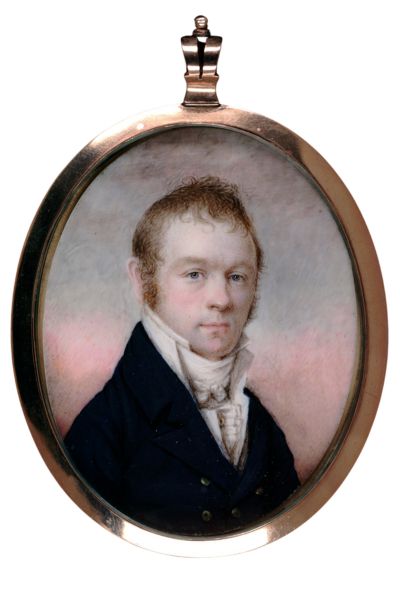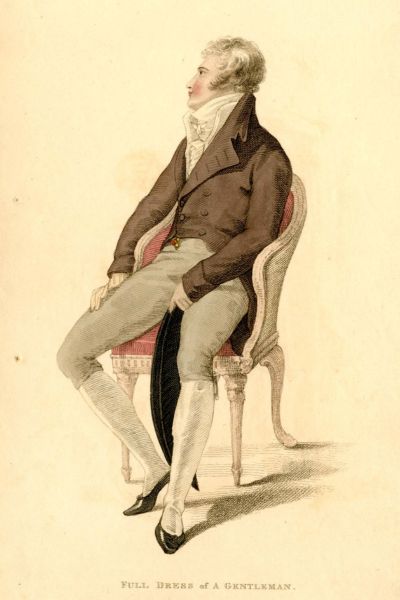Prices and Availability Subject to Change. Please call 800-997-4311 for more Information.
1800s Men's Clothing Guide
As fashion promenaded into the Regency era, men's style stepped away from the once-popular look of a powdered-wig peacock and toward that of a notably understated yet impeccably dressed dandy. Gone were flamboyant vests, coats and pantaloons cut from stiff silks in vivid colors adorned with elaborate embroidery. In France, limited availability of fine textiles during the French Revolution, along with the fear of looking aristocratic enough to be delivered to the guillotine, were partially behind this swing toward a more sedate color palette. A growing fascination with the classical, since the discovery of Pompei and Herculaneum, and the interest in the ideal of ancient democracies, inspired new silhouettes in both men and womenswear.
However, the turn of the 19th century marked the era of the English tailor, praised for their skill with woolen suiting and impeccable attention to fit. Society figures like Beau Brummel, celebrated for his flawlessly executed style, popularized this new look, and English country style, popular in certain circles since the 1780s, became mainstream fashion for menswear in both England and France. This shift in men's fashion marked the first separation between menswear and womenswear in terms of decoration and fabrics, and set the mold for how we think of menswear today.
Although men's fashion in the early 1800s was less conspicuous in construction and color, it was in no way unkempt or worn without discernment. Beau Brummel, an English dandy and high society hob-nobber, set the era's high standards for dressing and deportment. This arbiter of fashion brought focus to the quality of fabric and accuracy of the cut over the lavishness of the embroidery and color. This influence continues today in the staid blues, browns and blacks of most men's suits. Fastidious and with the finest of tastes, Brummel was known to spend extraordinary amounts of time and money on his wardrobe - some say he even polished his boots with champagne!

Coats
The fashionable coats of the 1800s reflected the increasing popularity of English country style, which was having its moment now that the excesses of pre-revolution fashions had been swept away. The dress coat (or justaucorps) of the previous century had fallen out of fashion and was now only worn at the Royal court.
There were two main types of fashionable coat, both derived from English riding coats - both cut away at the front for easier movement. By 1800, the tailcoat had become the standard for all formal occasions, both day and evening. Finely tailored in high quality wool of a muted shade - dark blue, red, green, brown or black, the tailcoat could be either single or double breasted, with a tall collar and wide notched lapels (either a V notch or an M notch was also fashionable in this period). The cutaway portion could either be cut straight across, or in an inverted U shape.
The second coat option was actually intended for riding. The Newmarket (which would later in the century develop into the morning coat, or cutaway) was a single breasted style of tailcoat which sloped gently to the tails, rather than being cut away squarely at the waist.



Vests
The vests of this decade could be single or double breasted, and were cut straight across, often an inch or so lower than the waist of the tailcoat, so as to show below it. They featured tall stand collars which could even include whalebone sewn into the front edges to keep them upright. They could button up to the neckline, military style, or have lapels which stood up around the elaborate neckwear they framed.
Never made in the same color as the coat, waistcoats were a chance to showcase more colorful fine fabrics, stripes, patterns and embroidery as the rest of menswear became more somber in color. It was also briefly fashionable to wear two contrasting waistcoats one over the other, the top cut to show off parts of the one underneath.


Shirts
Shirts worn under vest and coat were cotton or linen and the fashion was for plain white, with very tall collars sitting under the chin, and decorative frills down the front opening. Shirts of this era were still very square - they would not acquire their modern shape for many decades - and puffed out from the armholes of the vest for the typical Regency look.


Ties
Neckwear of the Regency period was an elaborate and much discussed feature of a man's wardrobe. In the 1800s, the main form worn was the cravat, a large square of starched muslin or silk which could be folded into a multitude of styles to create further volume at the neck, atop the flounces of the shirt front.
Pants
Breeches were still worn for day and evening into the 1800s, sitting high on the waist and cut just below the knee and fastened with buttons or buckles and ties but were increasingly slim fitting.
Originating in the previous decades and preferred among the fashionable however, were pantaloons, extending to the calf, then later the ankle and held in place with a strap under the instep. Both breeches and pantaloons were often made of fine wool cut on the bias so as to be very fitted, almost like tights.
Light colors were in vogue, contrasting against dark coats and colorful vests, and tucking breeches or pantaloons into tall military-style boots was the height of fashion for daywear and a favorite look of Beau Brummel himself.
Rather than the single opening of modern day, all Regency pants had a flap panel 5-8 inches wide called a fall that opened in the front and fastened with buttons, the single button fly did not come into common use until around 1840.

Evening Wear
It was in this regency era that the concept of correct evening attire began to appear - the fashionable man of the period would choose a dark blue or black tailcoat, with white shirt, white pique waistcoat and white silk or muslin cravat, and cream breeches with stockings and low, black polished leather shoes, fastened with ribbons tied into neat bows.
Hats
From the turn of the century, the top hat was to replace the tricorn entirely as the hat of choice for men for the next 50 years or so. Initially seen in a variety of shapes and colors, early top hats were predominantly made from wool felt or beaver pelt. The bicorne of the 18th century remained fashionable for evening wear, some were designed to collapse to be tucked under the arm and were called chapeau-bras.

Footwear
The high-heeled, big-buckled and often jewel-bedecked shoes of the 18th century gave way to leather laced shoes and knee-length boots, while heels were relegated to full court dress only. The flashy uniforms of the Napoleonic Wars (1803-1815) inspired a military theme in civilian clothing too, with breeches and pantaloons tucked into either a Hessian boot, which were knee height and often featured a decorative tassel, or the square-toed and lower-cut Wellington, named for the British duke and general. Wellingtons continued to be worn into the 1840s as they could be worn underneath the newly fashionable trousers.
For evening, black leather dress pumps were worn, fastened with ribbons tied into neat bows.


Hair & Accessories
Elaborate powdered hairstyles were left in the previous century, as Regency men began to cut their hair short and leave it natural. Classically inspired, like much of the fashion of the time, these hairstyles had names like a la Titus or Brutus. A gentleman would also wear a watch, tucked into a pocket in the breeches, with seals and fobs hanging from the chain attached to the waist and visible below the waistcoat.

Q&A About 1800s Men's Fashion
What did men wear in the 1800s?
What did upper class men wear in the 1800s?
What did lower class men wear in the 1800s?

Complete Regency Outfits
We offer a full line of men's period clothing which are suitable for movie and TV production, theatrical, living history and performing arts requirements, and are also perfect for vintage weddings!
All of the products we sell are sold individually, but we have put together these full outfits to showcase the elements of Regency style for your consideration and inspiration.
Click any image for a close-up and a list of the products shown.



